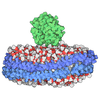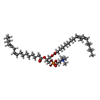[English] 日本語
 Yorodumi
Yorodumi- PDB-7dce: Cryo-EM structure of human XKR8-basigin complex bound to Fab fragment -
+ Open data
Open data
- Basic information
Basic information
| Entry | Database: PDB / ID: 7dce | ||||||||||||||||||||||||
|---|---|---|---|---|---|---|---|---|---|---|---|---|---|---|---|---|---|---|---|---|---|---|---|---|---|
| Title | Cryo-EM structure of human XKR8-basigin complex bound to Fab fragment | ||||||||||||||||||||||||
 Components Components |
| ||||||||||||||||||||||||
 Keywords Keywords | TRANSPORT PROTEIN / XKR8 / basigin / scramblase / phospholipid | ||||||||||||||||||||||||
| Function / homology |  Function and homology information Function and homology informationDefective SLC16A1 causes symptomatic deficiency in lactate transport (SDLT) / Proton-coupled monocarboxylate transport / phosphatidylserine exposure on apoptotic cell surface / tolerance induction to self antigen / positive regulation of matrix metallopeptidase secretion / acrosomal membrane / phospholipid scramblase activity / neutrophil clearance / response to mercury ion / engulfment of apoptotic cell ...Defective SLC16A1 causes symptomatic deficiency in lactate transport (SDLT) / Proton-coupled monocarboxylate transport / phosphatidylserine exposure on apoptotic cell surface / tolerance induction to self antigen / positive regulation of matrix metallopeptidase secretion / acrosomal membrane / phospholipid scramblase activity / neutrophil clearance / response to mercury ion / engulfment of apoptotic cell / endothelial tube morphogenesis / neural retina development / apoptotic process involved in development / photoreceptor cell maintenance / Basigin interactions / Aspirin ADME / odontogenesis of dentin-containing tooth / D-mannose binding / decidualization / positive regulation of vascular endothelial growth factor production / photoreceptor outer segment / Integrin cell surface interactions / positive regulation of myoblast differentiation / response to cAMP / neutrophil chemotaxis / embryo implantation / Degradation of the extracellular matrix / photoreceptor inner segment / positive regulation of endothelial cell migration / establishment of localization in cell / protein localization to plasma membrane / sarcolemma / response to peptide hormone / positive regulation of interleukin-6 production / melanosome / signaling receptor activity / virus receptor activity / basolateral plasma membrane / angiogenesis / positive regulation of viral entry into host cell / cell surface receptor signaling pathway / endosome / cadherin binding / Golgi membrane / intracellular membrane-bounded organelle / focal adhesion / endoplasmic reticulum membrane / perinuclear region of cytoplasm / mitochondrion / extracellular exosome / membrane / plasma membrane Similarity search - Function | ||||||||||||||||||||||||
| Biological species |  Homo sapiens (human) Homo sapiens (human) | ||||||||||||||||||||||||
| Method | ELECTRON MICROSCOPY / single particle reconstruction / cryo EM / Resolution: 3.8 Å | ||||||||||||||||||||||||
 Authors Authors | Sakuragi, T. / Kanai, R. / Tsutsumi, A. / Narita, H. / Onishi, E. / Miyazaki, T. / Baba, T. / Nakagawa, A. / Kikkawa, M. / Toyoshima, C. / Nagata, S. | ||||||||||||||||||||||||
| Funding support |  Japan, 7items Japan, 7items
| ||||||||||||||||||||||||
 Citation Citation |  Journal: Nat Struct Mol Biol / Year: 2021 Journal: Nat Struct Mol Biol / Year: 2021Title: The tertiary structure of the human Xkr8-Basigin complex that scrambles phospholipids at plasma membranes. Authors: Takaharu Sakuragi / Ryuta Kanai / Akihisa Tsutsumi / Hirotaka Narita / Eriko Onishi / Kohei Nishino / Takuya Miyazaki / Takeshi Baba / Hidetaka Kosako / Atsushi Nakagawa / Masahide Kikkawa / ...Authors: Takaharu Sakuragi / Ryuta Kanai / Akihisa Tsutsumi / Hirotaka Narita / Eriko Onishi / Kohei Nishino / Takuya Miyazaki / Takeshi Baba / Hidetaka Kosako / Atsushi Nakagawa / Masahide Kikkawa / Chikashi Toyoshima / Shigekazu Nagata /  Abstract: Xkr8-Basigin is a plasma membrane phospholipid scramblase activated by kinases or caspases. We combined cryo-EM and X-ray crystallography to investigate its structure at an overall resolution of 3. ...Xkr8-Basigin is a plasma membrane phospholipid scramblase activated by kinases or caspases. We combined cryo-EM and X-ray crystallography to investigate its structure at an overall resolution of 3.8 Å. Its membrane-spanning region carrying 22 charged amino acids adopts a cuboid-like structure stabilized by salt bridges between hydrophilic residues in transmembrane helices. Phosphatidylcholine binding was observed in a hydrophobic cleft on the surface exposed to the outer leaflet of the plasma membrane. Six charged residues placed from top to bottom inside the molecule were essential for scrambling phospholipids in inward and outward directions, apparently providing a pathway for their translocation. A tryptophan residue was present between the head group of phosphatidylcholine and the extracellular end of the path. Its mutation to alanine made the Xkr8-Basigin complex constitutively active, indicating that it plays a vital role in regulating its scramblase activity. The structure of Xkr8-Basigin provides insights into the molecular mechanisms underlying phospholipid scrambling. | ||||||||||||||||||||||||
| History |
|
- Structure visualization
Structure visualization
| Movie |
 Movie viewer Movie viewer |
|---|---|
| Structure viewer | Molecule:  Molmil Molmil Jmol/JSmol Jmol/JSmol |
- Downloads & links
Downloads & links
- Download
Download
| PDBx/mmCIF format |  7dce.cif.gz 7dce.cif.gz | 175 KB | Display |  PDBx/mmCIF format PDBx/mmCIF format |
|---|---|---|---|---|
| PDB format |  pdb7dce.ent.gz pdb7dce.ent.gz | 133.7 KB | Display |  PDB format PDB format |
| PDBx/mmJSON format |  7dce.json.gz 7dce.json.gz | Tree view |  PDBx/mmJSON format PDBx/mmJSON format | |
| Others |  Other downloads Other downloads |
-Validation report
| Summary document |  7dce_validation.pdf.gz 7dce_validation.pdf.gz | 859.2 KB | Display |  wwPDB validaton report wwPDB validaton report |
|---|---|---|---|---|
| Full document |  7dce_full_validation.pdf.gz 7dce_full_validation.pdf.gz | 870 KB | Display | |
| Data in XML |  7dce_validation.xml.gz 7dce_validation.xml.gz | 30.6 KB | Display | |
| Data in CIF |  7dce_validation.cif.gz 7dce_validation.cif.gz | 45.8 KB | Display | |
| Arichive directory |  https://data.pdbj.org/pub/pdb/validation_reports/dc/7dce https://data.pdbj.org/pub/pdb/validation_reports/dc/7dce ftp://data.pdbj.org/pub/pdb/validation_reports/dc/7dce ftp://data.pdbj.org/pub/pdb/validation_reports/dc/7dce | HTTPS FTP |
-Related structure data
| Related structure data |  30636MC 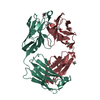 7d9zC 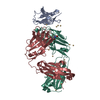 7daaC M: map data used to model this data C: citing same article ( |
|---|---|
| Similar structure data | |
| EM raw data |  EMPIAR-11046 (Title: Human Xkr8-Basigin complex bound to Fab fragment / Data size: 451.5 / Data #1: Unaligned K3 movies [micrographs - multiframe]) EMPIAR-11046 (Title: Human Xkr8-Basigin complex bound to Fab fragment / Data size: 451.5 / Data #1: Unaligned K3 movies [micrographs - multiframe]) |
- Links
Links
- Assembly
Assembly
| Deposited unit | 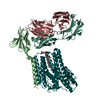
|
|---|---|
| 1 |
|
- Components
Components
| #1: Protein | Mass: 19592.814 Da / Num. of mol.: 1 / Mutation: N152Q, N186Q Source method: isolated from a genetically manipulated source Source: (gene. exp.)  Homo sapiens (human) / Gene: BSG, UNQ6505/PRO21383 / Production host: Homo sapiens (human) / Gene: BSG, UNQ6505/PRO21383 / Production host:  |
|---|---|
| #2: Protein | Mass: 45975.609 Da / Num. of mol.: 1 Source method: isolated from a genetically manipulated source Source: (gene. exp.)  Homo sapiens (human) / Gene: XKR8, XRG8 / Production host: Homo sapiens (human) / Gene: XKR8, XRG8 / Production host:  |
| #3: Antibody | Mass: 22869.639 Da / Num. of mol.: 1 Source method: isolated from a genetically manipulated source Source: (gene. exp.)   Homo sapiens (human) Homo sapiens (human) |
| #4: Antibody | Mass: 23261.865 Da / Num. of mol.: 1 Source method: isolated from a genetically manipulated source Source: (gene. exp.)   Homo sapiens (human) Homo sapiens (human) |
| #5: Chemical | ChemComp-DLP / |
| Has ligand of interest | Y |
-Experimental details
-Experiment
| Experiment | Method: ELECTRON MICROSCOPY |
|---|---|
| EM experiment | Aggregation state: PARTICLE / 3D reconstruction method: single particle reconstruction |
- Sample preparation
Sample preparation
| Component |
| ||||||||||||||||||||||||
|---|---|---|---|---|---|---|---|---|---|---|---|---|---|---|---|---|---|---|---|---|---|---|---|---|---|
| Molecular weight | Value: 0.11 MDa / Experimental value: NO | ||||||||||||||||||||||||
| Source (natural) |
| ||||||||||||||||||||||||
| Source (recombinant) |
| ||||||||||||||||||||||||
| Buffer solution | pH: 7 | ||||||||||||||||||||||||
| Specimen | Embedding applied: NO / Shadowing applied: NO / Staining applied: NO / Vitrification applied: YES | ||||||||||||||||||||||||
| Vitrification | Cryogen name: ETHANE |
- Electron microscopy imaging
Electron microscopy imaging
| Experimental equipment |  Model: Titan Krios / Image courtesy: FEI Company |
|---|---|
| Microscopy | Model: FEI TITAN KRIOS |
| Electron gun | Electron source:  FIELD EMISSION GUN / Accelerating voltage: 300 kV / Illumination mode: FLOOD BEAM FIELD EMISSION GUN / Accelerating voltage: 300 kV / Illumination mode: FLOOD BEAM |
| Electron lens | Mode: BRIGHT FIELD / Nominal defocus max: 1800 nm / Nominal defocus min: 800 nm |
| Image recording | Electron dose: 48 e/Å2 / Film or detector model: GATAN K3 (6k x 4k) |
- Processing
Processing
| CTF correction | Type: PHASE FLIPPING AND AMPLITUDE CORRECTION |
|---|---|
| 3D reconstruction | Resolution: 3.8 Å / Resolution method: FSC 0.143 CUT-OFF / Num. of particles: 62124 / Symmetry type: POINT |
 Movie
Movie Controller
Controller



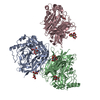

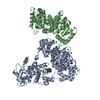

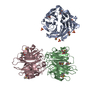
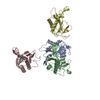
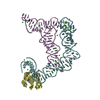
 PDBj
PDBj







